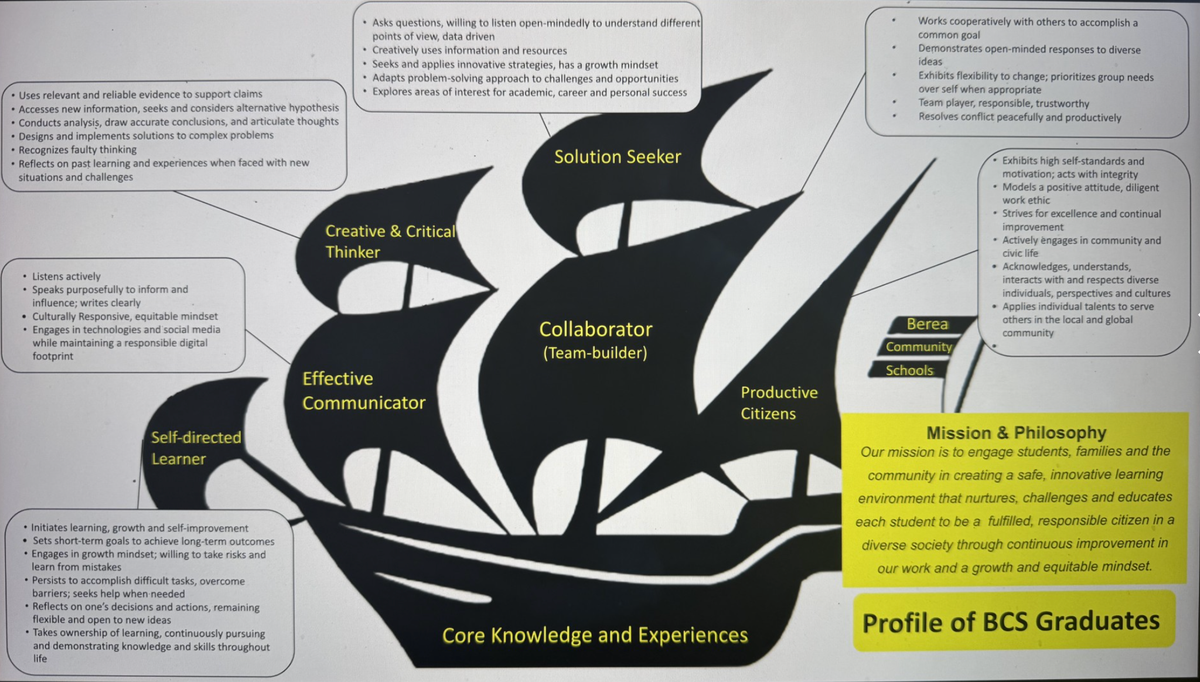Why is a poster of a pirate ship virtually all that remains of $378K spent on consultant?
Ron Chi,PhD, an educational consultant, was paid with general funds by District that did not implement much of his wozrk

BEREA— There are those who, when they were either on the board of or employed by the Berea Independent Schools District, worked with education consultant Ronald Chi, PhD, held him in high regard. They still do to this day.
“I’m working with him now on a project for the future,” Charlie Brock, a former administrator in the Berea District, now superintendent of Estill County Schools, told The Edge in an interview. “He is very helpful,” Brock added.
“I thought he was very professional, very good at what he does,” Van Gravitt, former chair of Berea’s board of education — and the one whose signature appears on the original contract with Chi — told The Edge in an interview. “We were happy to have him.”
But the fact that those who knew and worked alongside Chi between 2019 and 2024 have since left the District, has meant that much of what they did together — and which cost the District $378,000 for them to do it — is mostly forgotten.
This is compounded by multiple accounts of the many District employees who actively fought against Chi and his initiatives, which were supported by the board of education and Diane Hatchett, PhD, then superintendent.
Ultimately, not much was accomplished.
“My goal was to help Berea establish a district-wide framework of aligned supports for students and educators,” Chi said. “While the implementation of this system was hindered by frequent leadership turnover and limited general fund investments, the conversations and strategic planning provided a blueprint for how Berea might sustainably move forward.”
The blueprint is not currently in use.
Portrait of a Graduate
Chi was first hired by Berea’s District in late October 2019 to create a “portrait of a graduate” by the end of January 2020. Chi charged the District $425 per each day worked during those three months. The math on that, when calculating for multiple holidays and weekends is about $23,375.
The POG, as Portrait of a Graduate is often referred to, is part of a novel trend rooted in the work of Battelle for Kids, a Columbus, Ohio-based education nonprofit which claims their movement helps schools create a “future-ready, deeper learning vision for every student”.
The POG has taken hold with public school districts across the country over the past decade. The system is not mandatory in Kentucky, but in a conversation The Edge had with Jennifer Ginn, director of communications for the Kentucky Department of Education, she indicated it is favored, and that it informs the state’s United We Learn initiative that also seeks to make students “future ready”.
Hatchett was already trying to move the District in that direction and had learned about POG before she called upon Chi, a well-known educational systems consultant in the region, to help create momentum for it, according to Chi.
“Consultants are often contracted by districts to provide guidance through the POG development process,” Chi told The Edge. “The roll out is typically facilitated by district/building leaders.”
Chi was hired to see to the following:
“The empowerment of the entire school district, surrounding community, and Berea College” to identify the post-secondary school competencies necessitated by success in the 21st century “and for life’s ventures”; the “empowerment” of staff members to engage in real personalized learning [italics in the contract] events; and to make international connections so students could work “hand-in-hand on global student-initiated projects and begin to impact another country’s educational system.”
Thanks to Covid, the POG roll-out didn’t roll far.

According to Chi, a POG description was created. It was a graphic of a pirate ship with desirable graduate characteristics written across the sails.
“That diagram/framework was presented to the board by the superintendent and ultimately posted on the school district website,” Chi wrote in an email to The Edge.
Today, aside from the poster of the pirate ship, very little remains of the effort. “Many POG efforts ended when Berea leadership changed,” Chi said.
High attrition, low morale
When Chi’s initial three month contract was up in early 2020, the Board asked him to stay on at Hatchett’s request.
“The superintendent identified an ongoing need for my support in sustaining programs that had already been established,” Chi said. “This included assisting with the transition of those programs to newly hired members of her administrative teams.”
The “newly hired” part soon established itself as a trend.
By early 2021, Hatchett was about 18 months into her tenure which, notably, included the pandemic lockdowns. About that time, there began to grow an outsized rate of attrition. The number of administrative staff who left between 2021 and 2023 included four directors of academics, three elementary principals, two middle school principals, and three high school principals.
There were also those that Hatchett reassigned within District, or who were given double assignments when a staff member left but wasn’t replaced.
Remaining staff impacted by the constant turnover and assignment switcheroos told The Edge the constant change was destabilizing and contributed to an uneasy work environment where some administrators jockeyed for greater influence.
Multiple attempts to contact Hatchett went unanswered, but it appears keeping Chi on to intervene however indirectly was part of her strategy to quell office politics and curtail the attrition.
Chi observed to The Edge that top personnel in the District, “didn’t always agree on the future of the school district. It makes it quite difficult to establish new initiatives if leadership is not on the same page. I try to empower people as much as possible to ensure ownership of responsibilities takes place. That requires significant time and trust-building efforts.”
Questions about how Chi was paid
Chi told The Edge he believes his services were paid from grant monies.
In particular, Chi said the District used federal Covid-era ESSER funds (Elementary and Secondary School Emergency Relief). These monies were distributed to public schools beginning in late March 2020, to help them innovate solutions to the challenges created by the pandemic shutdown.
“ESSER funding made it possible for districts like Berea to explore bold ideas and reimagine how education could better serve students -- not just during a crisis, but well beyond it,” Chi said. “My role was to guide, elevate, and support that effort in collaboration with those who lead the work every day.”
In fact, Chi was only partially paid with federal grants.
“Looking at the accounts on the purchase orders, around two-thirds was paid out of various ESSER/CARES Act funds and one-third was paid out of the general fund,” District finance officer, Nathan Sweet, told The Edge in an email. The CARES Act was passed during Covid to distribute aid to individuals and some public systems, including schools.
Chi couldn’t have known this, though, according to Sweet. “The way that the accounts are listed on purchase orders, it is unlikely that he would have recognized the funding source even if he had a copy,” Sweet said.
Chi did not think his payment was being drawn from the general fund because according to him, he was told it wasn’t.
“Dr. Hatchett and the director of finance both assured me that my services were solely paid out of grant funds,” Chi said. The director of finance at the time was Tony Tompkins, who announced his retirement at the end of last year. Tompkins recently became a consultant at Estill County Schools. Attempts to reach Tompkins by publication time were unsuccessful.
The general fund is a district’s pot of cash that by state statute is to be dedicated to operating expenses, without which, a District cannot function. According to state statute, consultants can be considered an operational expense.
Since the $23,375 paid to Chi for his initial work for the District occurred before Covid, ESSER monies wouldn’t have been available. Unless there was a specific grant to cover his costs — which according to Sweet, there wasn’t — the general fund would have been the only source of payment.
If as Sweet said, one-third of the $378,000 paid to Chi by the District over the years came from the general fund, that is about $126,000. Subtracting $23,375 for the initial contract leaves about $102,000.
What was that money spent on exactly?
For one thing, the “trust-building” performed by Chi that was meant to address the toxic environment. But there were other services.

Additional services
Chi said that he was asked to stay on throughout the pandemic, “Not only to navigate the challenges of virtual learning, but also to lay the groundwork for new high school initiatives.”
During the pandemic, Chi said he helped prepare the District for its acceptance into the ChanZuckerberg Initiative’s Summit Learning platform. “This was a critical step toward building instructional continuity in the face of school closures,” Chi said. “While platform feedback varied and the initiative later shifted due to leadership changes, the effort created a foundation for future digital learning strategies.”
After the pandemic, Chi claims that tangible results of his time working with the District includes the expansion of the career and technical information (CTE) program through the development of, “pathways that aligned with both academic and workforce readiness goals. These programs were structured to give students access to real-world, skills-based learning, which is central to ESSER’s emphasis on re-engaging students and supporting long-term educational recovery.”
His work to develop CTE pathways, he said, resulted in the District receiving $300,000 in state CTE funds Hatchett and the Board were previously unaware were available, according to Chi.
“These programs were instrumental in redefining how the community measures student achievement and success,” Chi said. “The CTE programs served as a foundation to operationalize and validate Berea’s POG accountability system.”
The Edge was unable to verify these claims entirely, despite asking several current District staff. Many of them were familiar with the success of the CTE programming, but none had any idea what the POG was, even when showed the pirate ship graphic. One elementary school teacher, however, did note that some of the curricula she has worked with over the years does reflect some of the values written on the ship’s sails.
Chi also listed his efforts to help students connect their mental health to their level of engagement in school. “My consulting emphasized the intersection of academic learning and social-emotional wellness. I challenged leaders to rethink what learning could look like during a crisis -- not just sustaining instruction, but creating experiences that promote student hope, curiosity, and mental health,” he said.
Another legacy Chi claimed was that blueprint for the “district-wide framework of aligned supports for students and educators to move forward sustainably”, that has yet to be implemented.
By 2022, Chi said his engagement by the District was revised to be on an “as-needed” basis to be determined by Hatchett. Roles Chi said he performed from that point forward included, “after-hours consultation with the District’s director of academics (now no longer with the district), school climate leader, and various building administrators.”
‘International connections’
As for the international programs, Covid made continuing such connections tricky, Chi said.
“While we initially partnered with Pollard International School in China, the pandemic limited Berea’s ability to fully collaborate and implement classroom-based problem-solving opportunities,” he said.
Instead, with Chi’s help the District pivoted to one-on-one virtual visits between “selected” Community School students with “selected” students in Korea in order, “to collaboratively develop educational programs and learning experiences tailored to their peers.”
Not a single staff member interviewed by The Edge could recall anything about this international exchange. This lack of recollection made it difficult to find any students who participated in the program. The Edge did not succeed in finding any.
End of an era
Despite being told early in his work with the District that they would have liked to hire him on full-time, Chi said an offer didn’t come in time before he accepted an offer from Fayette County Public Schools and in July 2022, became that district’s chief innovation officer. Chi said however, that the Board approved keeping him on as a consultant for the 2022-23 school year. “I sincerely thanked them, but took the offer at Fayette,” Chi said.
The last invoice from Chi, in the amount of $25,000, was dated September 2024. It was paid in December.
Whatever accomplishments occurred during Chi’s time with the District, very little is in operation. Despite the many obstacles placed in his way by some District staff, Chi said, “I remained committed to empowering Berea leadership to carry that vision forward on their own terms.”
The original contract called for Chi to give a “thorough report” of his POG assessment. This might have been of some use to the current administration and the incoming superintendent should they desire to implement the POG, but in the end, there was no report.
“The superintendent communicated with me that a formal presentation to the Board was not required, and therefore, the reporting process outlined in the MOA [memorandum of agreement] was not made necessary,” Chi said.
Aside from the CTE programming, after spending $378,000, it seems the only tangible asset for the District is a poster of a pirate ship.
The Edge is Berea’s source for real journalism. Support this work with a paid subscription.
Update: On Monday, May 12, 2025, at 9:24 PM, this story was updated to reflect that the board of Berea Independent Schools offered Dr. Chi a contract to consult in 2022-2023, but Chi turned it down in favor of a full-time job with Fayette County.
